One advantage of being unemployed is that you have more free time. This is key when an email goes out to the listservs about a Prothonotary Warbler being seen next to the famous lions outside the “main branch” of the New York City Library, which is next to Bryant Park. As quickly as I could I gathered all the necessary items that one needs when making an outing with a ten-month-old and we were out the door on the way to 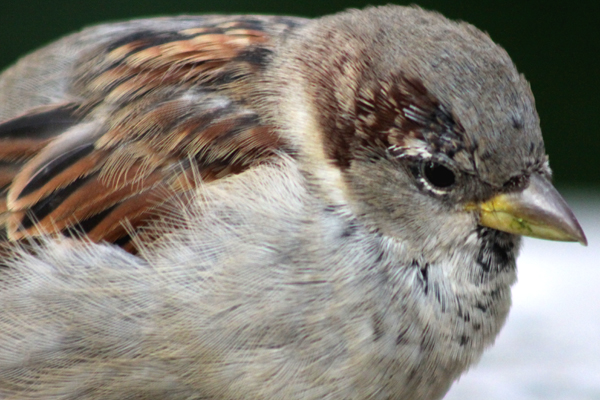 the subway where I was reminded of one of the negatives of being unemployed: you don’t bother to buy a monthly metrocard so you have to actually pay full fare for the subway. Oh well, getting Desi a Prothonotary Warbler for his first twitch is well worth $2.25 each way on the subway.
the subway where I was reminded of one of the negatives of being unemployed: you don’t bother to buy a monthly metrocard so you have to actually pay full fare for the subway. Oh well, getting Desi a Prothonotary Warbler for his first twitch is well worth $2.25 each way on the subway.
We were out of the train at Bryant Park and hustling across 40th Street to 5th Ave in no time and were looking at House Sparrows, White-throated Sparrows and a couple Yellow-bellied Sapsuckers a couple of minutes later. Birders were gathering and it wasn’t long before cries of “We have the bird!” went up.
And did folks ever have the bird! Cooperative isn’t even the word. Unfortunately, we were not in a good spot, up above the bird, especially compared to those who were at its level and taking pictures like the one above by Stephanie as the Prothonotary Warbler hid behind an office worker’s legs. Nonetheless, Desi’s first views of a twitched bird were, well, amazing. He, however, seemed more interested in the pigeons in the vicinity and, of course, in the loud trucks and buses on 5th Avenue.
We stuck around awhile, hoping for more looks like that, but except for a brief glimpse while I was busy changing Desi’s diaper we did not see the bird again. As good as the bird was the fact that Desi fell asleep on the train ride home, finally, after having refused to nap all day until that point was even better.
And for those who question whether or not a ten-month-old can appreciate twitching a wood-warbler, well, you haven’t met Desmond Shearwater yet, have you?
…

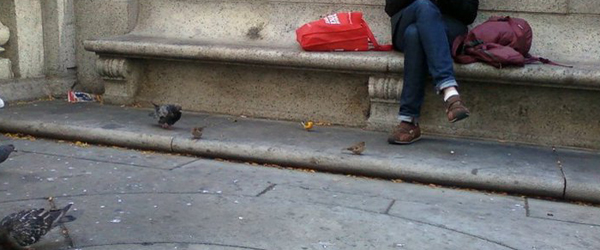
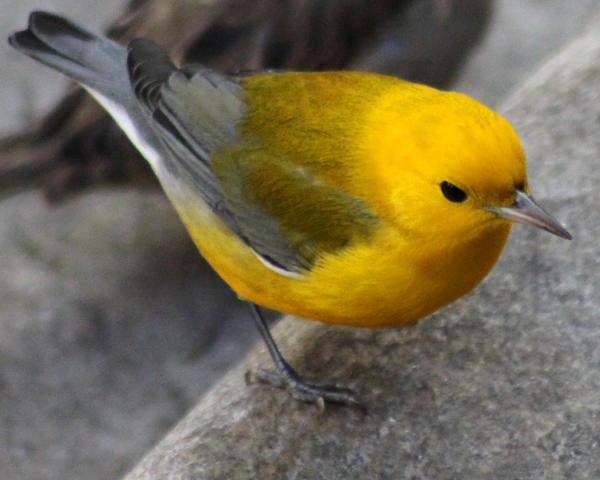
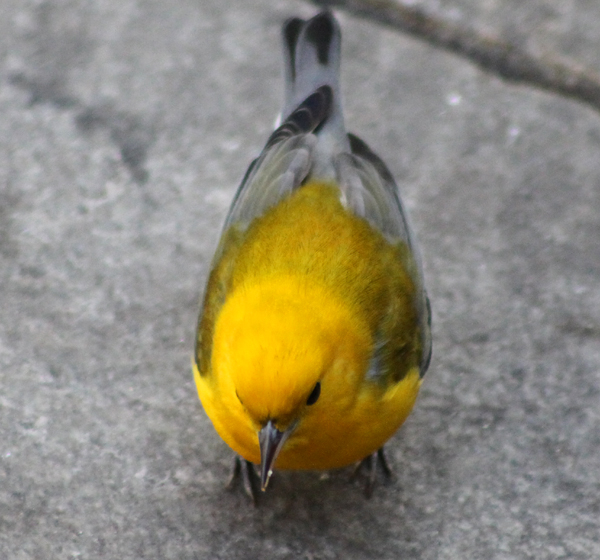
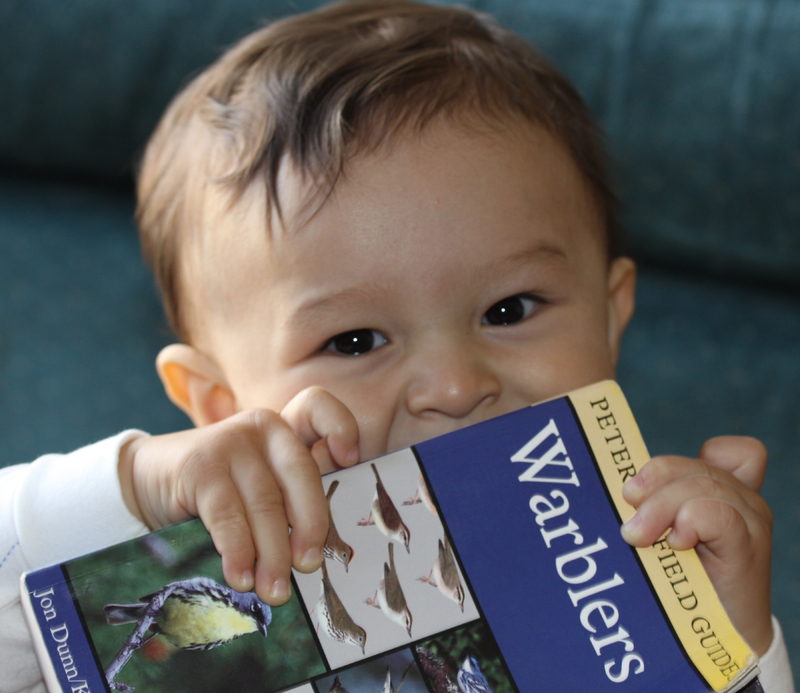










Nice! Noah’s first twitch was a Varied Thrush. We missed it. I’m pleased to see your progeny brings better luck.
Awesome! I haven’t taken Jules for a real bird chase yet. I’m waiting for something to show up. That Protho is insane. What a gorgeous bird. Definitely out of place, especially this time of year.
Wonderful and heartwarming story. So glad Desi got the bird. And it looked like the field guide tasted good, too.
My daughter’s first bird (coming up on 25 years ago), and this might have been her last as she’s a ‘city girl’ now, was a Black-capped Chickadee in Forest Park, Queens. I was backpacking her along the trails as I often did, and we came upon a man feeding chickadees and titmice at the Waterhole, from his hand. With my daughter still on my back, he smiled and told me to put out an open hand. He then poured some seed onto my palm. Within a few seconds, the birds that he had apparently trained for some time, landed on my palm or thumb, grabbed some seed and left. They repeated this until the seed was finished. All the while, my daughter was laughing delightedly at this spectacle. I could never forget this wonderful event.
Every child should have such memories.
Reminds me of my 1st and only Protho Warbler. I was doing the NYC Audubon big day and we had stopped at a hot dog stand in Brooklyn and as we were standing there, one popped out of the bush next to us.
But yeah… those photos.
This bird was simply awesome! As amazing as my looks were, they were brief, but brilliant. When I saw it, it was taking refuge under a homeless person’s foot, and I barely missed the bird on top of the same man’s backpack! Thanks for posting the photos–I was wondering about the age of the bird, and though there’s talk of it being a first fall male, it seems like a pretty solid adult male. According to Pyle, Dunn and Garrett, the bill is always drabber in fall than spring, and younger birds should show more extensive olive on the back of the head. Even the fall adult male in the Garrett/Dunn book shows olive on the back of the head. However, in pyle’s description of PROW molt, he says they begin on the breeding grounds, suspend the molt, and complete it over the winter. This perfectly explains the head color, and the visible molt gap in the secondaries in your first photo. Also, there was a lot of white in the tail of this bird, further supporting the sex. Sorry to get all analytic, but I just got the pyle books and this was a great bird to try them out!!!
Our 3 year old nephew in Sydney noticed the birds in the park “were not the normal ones” one day & told my sister to check the book! They were Long-Billed Corellas. Go George! A Sacred Kingfisher hit a neighbours house & was to be taken to rehab, but George was worried it needed a toy while it waited to be collected & we have a great photo of a Kingfisher with a toy truck in a box! It came good!
Having soaked up all the facts, Desi disposes of the now useless book and decides to write something much better and comprehensive, possibly about Empids or old world larks, if only his parents would finally get him a laptop!
What a great story and beautiful photos of a lovely bird.
Sweet photos and story!
Congratulations: nice mix of birding, parenting, living in NY, and the new style of birding mixed with technology.
Lovely! If that poor warbler never makes it out of Bryant Park, it will have served a high purpose in delighting a good daddy and his takealong boy. Well do I know the triumphant feeling of stealing a little excursion on the baby’s time.
Best birding/parenting moment: when Phoebe was barely talking, she was riding in the backpack when we were well down in our woods. Hadn’t fallen asleep yet, but was getting there. And a ruffed grouse exploded right beside us. “OH! Phoebe! That was a grouse!”
A couple of beats pass…
“GOWSE!!”
And I craned my neck to see my daughter grinning widely with her two bottom teeth and a drool-slick chin, having just repeated the name of the bird that surprised her.